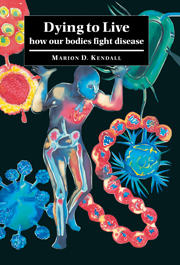3 - Patterns of Life
Published online by Cambridge University Press: 29 September 2009
Summary
Allergies It has been estimated that, in developed societies, about one in four people are allergic to something. Most of these suffer hayfever, which is a form of allergic rhinitis, or asthma. Many allergens (i.e. antigens that cause allergies in hypersensitive people) have been isolated and described in detail. These allergens are generally antigens derived from plant or fungal proteins. However, allergy to cats is the most common allergic condition world-wide, followed by allergy to house mite dust. All babies are capable of being allergic to foods and inhaled allergens, since their immune system is just developing the ability to react in an adult manner. Generally they only receive breast milk or formula feed for several months so the reactions are not common but, if foods are not introduced slowly enough, babies up to about nine months to one year of age can show allergic responses. Then the body learns to tolerate, or not react to, the potentially allergenic substances and the baby can eat a mixed diet without reactions. About 2–5% of adults remain allergic to foods such as cow's milk, peanuts or seafoods, and about 5–10% of children may suffer asthma, with the numbers rising each year. One-third of these may grow out of asthma, but another 10% of adults are newly added to the list of sufferers. The cost of asthma to the American economy in 1990 alone was around $3.6 billion.
- Type
- Chapter
- Information
- Dying to LiveHow our Bodies Fight Disease, pp. 35 - 54Publisher: Cambridge University PressPrint publication year: 1998



